
Materials for Tying Saltwater Fishing Flies
This section provides information about saltwater fly tying materials.
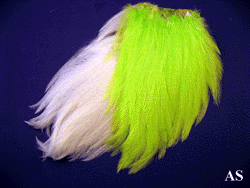
Feathers
Feathers
Hackle feathers for saltwater deceivers are obtained from rooster necks. You usually purchase a whole neck or half neck. Some roosters are specially bred to grow long neck hackles with stiff, bright fibers of constant length and slender stems. Necks come in grades of "Gold", "Silver", or "Bronze", with "Gold" of course being the most expensive, but having the finest quality feathers.
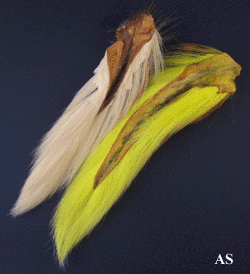
Bucktail
Natural Streamer Hair
Bucktail is the most popular natural material used for streamer hair. Bucktail hairs have a natural taper that gives it superior action in the water.
Bucktail is an easy material to work with.
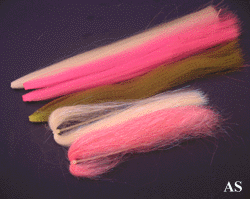
Super-Hair and Angel-Hair
Synthetic Streamer Hair
Examples of synthetic streamer hair include Ultra-Hair, Super-Hair, and Angel-Hair. Super-Hair and Angel-Hair are shown in the picture. Super-Hair is a little stiffer than Angel-Hair. Angel-Hair is very soft. Synthetic hair provides an alternative to bucktail with which you can achieve some interesting translucent effects.
Two new synthetic hairs you might
want to try are:
1. Eric Puglisi "Sparkle" is a
shimmering material used in all the Puglisi flies.
2. Steve Farrar's "Flash Blend", a slightly kinky
streamer material with a fine Angel-Hair flash.

Flash Blend
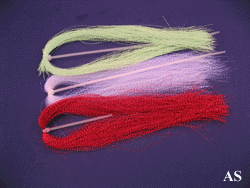
Krystal Flash
Flash
Examples of flash include Krystal Flash, Polar Flash, Flashabou, and others. Krystal Flash is shown in the picture. Mix a little in with the streamer hair to give the fly some sparkle that may get a striper's attention.
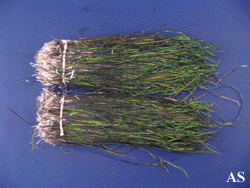
Peacock Herl
Toppings
A popular topping is Peacock Herl. The topping is tied along the top of the fly to achieve a dark top, like many baitfish. Peacock Herl is dark and it has a nice sheen. It is used particularly with Deceivers.
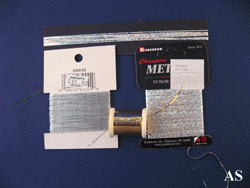
Mylar Tinsel
Mylar Tinsel
Mylar tinsel is usually gold or silver, but also comes in pearl. You can wrap the tinsel around the hook to provide some inner flash. You can also tie a couple strips along the side to add flash on the outside.
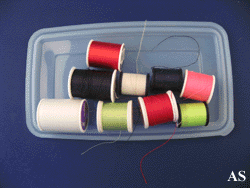
Fly Tying Thread
Fly Tying Thread
Thread is used to secure the various components of the fly to the hook. Fly tying thread comes in many sizes and colors. Size 6/0 is used for small flies. A larger diameter 3/0 size is usually used for streamers, including saltwater flies. Most fly tiers keep a wide assortment of thread handy.
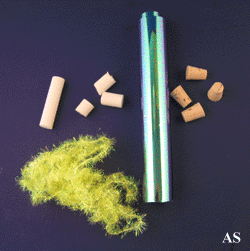
Foam and Cork Popper Bodies
Popper Bodies
Popper bodies can be balsa wood, cork, or foam. The Bob's Banger fly uses foam for the body. The green foil shown in the picture is to wrap around the foam body. The funny looking yellow stuff shown in the picture is Eratz, which is used for the tail.
Then you need stick-on eyes for the Popper. See below.
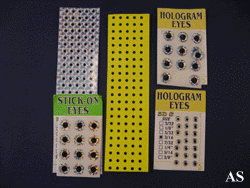
Stick-On Eyes
Stick-On Eyes
Stick-on eyes come in many sizes and colors. Some are like doll eyes and have some curvature. Some have holographic and prismatic effects. After you stick them on, coat them over with "Hard as Nails", so they don't come off.
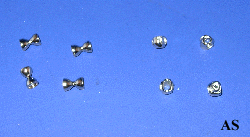
Weights
Weights
The picture shows two types of metal weights that are built in as
you tie the fly. The first are bar-bells. These are used for Clousers. The second
are coneheads. These are used for Jiggys.
Such weights come in brass, nickel, and tungsten. Tungsten is the heaviest.
Both type of weights have
recessed holes for stick-on eyes.
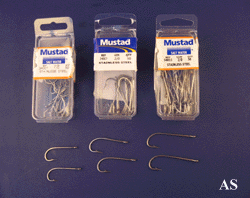
Saltwater Fly Tying Hooks
Saltwater Fly Tying Hooks
A good hook for tying most saltwater flies is the Mustad 34007. The Mustad 34011 has a little longer shank for tying poppers. Longer shank hooks are also a good choice if you are tying flies to catch bluefish. These Mustad hooks are made of stainless steel.
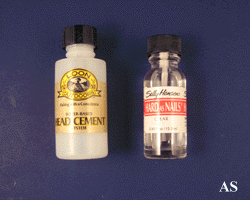
Head Cement and "Hard as Nails"
Head Cement
You will need some good head cement to bind the thread and to keep it from unraveling. An example is shown in the picture. Also shown is Sally Hansen's "Hard as Nails". This is normally used for protecting women's fingernails, but it is also good for giving fly heads a hard and tough finish.
ZAP-A-GAP quick drying super glue is also a useful item. Dab a little here and there as you build your fly.
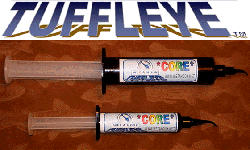
Tuffleye Acrylic Resin
Tuffleye Acrylic Resin
Surf Candy flies have always been tied using epoxy to shape the bodies. Recently a new material called "Tuffleye" has been introduced which is superior to epoxy for this purpose. Tuffleye is an acrylic resin that comes in the form of a gel. You use the gel to shape the body of the fly, then harden it using a blue light. The gel is easier to use than epoxy, and unlike epoxy, it won't yellow over time.
To find out more about Tuffleye Acrylic Resin follow this link: Tuffleye
Follow this link to see: Fly Tying Materials available on Amazon.com